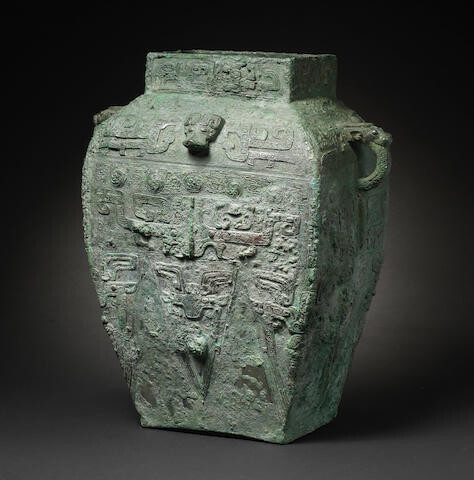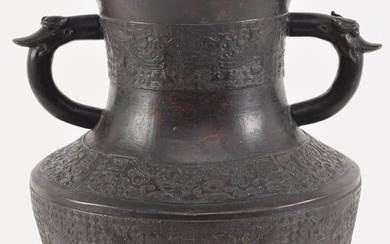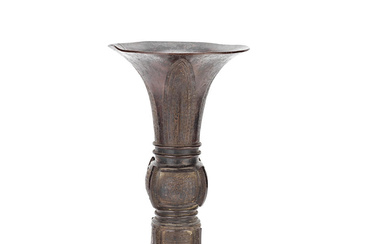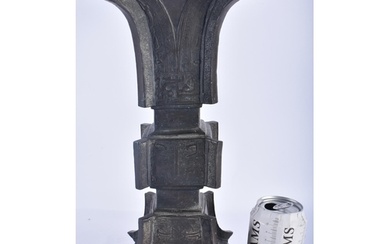A VERY RARE AND LARGE ARCHAIC BRONZE RITUAL WINE VESSEL, FANGLEI
Shang Dynasty
Shang Dynasty
Of rectangular section with high rounded shoulders, cast with eight large pendent triangular blades each enclosing a taotie mask above a small cicada and one with a central raised animal mask, each side with a broad band of further taotie divided by flanges against a leiwen ground below a band of domed whorls alternating with kui dragons, the shoulder cast with striding kui dragons on a leiwen ground flanking a high-relief bovine masks on the long sides and loop handles issuing from similar masks on the short sides, the straight neck with further pairs of confronted dragons divided by flanges, with a pictogram of a chariot and charioteers on the interior of the neck, Japanese box and cover.
39cm (15 1/4in) high. (2).
Please note this Lot is to be sold at No Reserve. 本拍品不設底價
商 青銅饕餮紋方罍
Provenance: a Japanese collection, acquired before the 1960s
Masaki Art Museum, Tadaoka, Japan
Sotheby's New York, 11-12 September 2012, lot 101
Published, Illustrated and Exhibited: Roger Keverne Ltd., Summer Exhibition, London, 2013, no.2.
來源:日本藏家舊藏,於二十世紀六十年代前入藏
日本忠岡町正木美術館舊藏
紐約蘇富比,2012年9月11-12日,拍品編號101
展覽著錄:Roger Keverne Ltd.,《夏季展覽》,倫敦,2013年,編號2
Fanglei existed as wine containers for only a short period during the late Shang to early Western Zhou dynasty, during which both highly decorated and plain fanglei were made and used side-by-side. Prior to the appearance of the lei, pou were used as wine containers. There was a short overlap of pou and lei and, by the late 12th century BC, pou had essentially disappeared.
Together with other bronze vessels manufactured for holding food and wine, the fanglei formed part of the ritual paraphernalia employed during the performance of important sacrifices to the ancestors of the highest-ranking families of the time. Honoured and commemorated through the use of these precious vessels, the ancestral spirits were encouraged to confer blessings on their descendants; while at the same time, the use of the vessel displayed, to the living, the power and wealth of their deceased owner.
The present vessel shares similar stylistic features with other published examples dating to the Shang and Zhou dynasties, namely large taotie masks on the lower body below either birds or dragons; dragons on the shoulder; and birds or dragons on the foot and neck; three handles, two on the shoulder and a third on one side of the lower body; and a mask on each side at the shoulder. The handles on the shoulders would have allowed the vessel to be carried or tied down with a cord, while a cord through the third handle would have held it secure as its contents were being poured out.
For a similar archaic bronze wine vessel and cover, Shang dynasty, see Tomb of Lady Hao at Yinxu in Anyang, Beijing, 1980, pl.32, figs.1 and 2; See another example illustrated by A.Juliano, Bronze, Clay and Stone: Chinese Art in the C.C.Wang Family Collection, Washington, 1988, no.2. Another example in the collection of the Nezu Art Museum, Tokyo, is illustrated by S.Mizuno, Bronzes and Jades of Ancient China, Tokyo, 1959, pls.62 and 63. See also a similar fanglei, with cover, Shang dynasty, said to be from Anyang, in the Museum fur Volkerkunde, Munich, illustrated by R.W.Bagley, Shang Ritual Bronzes in the Arthur M.Sackler Collections, Cambridge MA, 1987, fig.139.
View it on
Sale price
Estimate
Time, Location
Auction House
Shang Dynasty
Shang Dynasty
Of rectangular section with high rounded shoulders, cast with eight large pendent triangular blades each enclosing a taotie mask above a small cicada and one with a central raised animal mask, each side with a broad band of further taotie divided by flanges against a leiwen ground below a band of domed whorls alternating with kui dragons, the shoulder cast with striding kui dragons on a leiwen ground flanking a high-relief bovine masks on the long sides and loop handles issuing from similar masks on the short sides, the straight neck with further pairs of confronted dragons divided by flanges, with a pictogram of a chariot and charioteers on the interior of the neck, Japanese box and cover.
39cm (15 1/4in) high. (2).
Please note this Lot is to be sold at No Reserve. 本拍品不設底價
商 青銅饕餮紋方罍
Provenance: a Japanese collection, acquired before the 1960s
Masaki Art Museum, Tadaoka, Japan
Sotheby's New York, 11-12 September 2012, lot 101
Published, Illustrated and Exhibited: Roger Keverne Ltd., Summer Exhibition, London, 2013, no.2.
來源:日本藏家舊藏,於二十世紀六十年代前入藏
日本忠岡町正木美術館舊藏
紐約蘇富比,2012年9月11-12日,拍品編號101
展覽著錄:Roger Keverne Ltd.,《夏季展覽》,倫敦,2013年,編號2
Fanglei existed as wine containers for only a short period during the late Shang to early Western Zhou dynasty, during which both highly decorated and plain fanglei were made and used side-by-side. Prior to the appearance of the lei, pou were used as wine containers. There was a short overlap of pou and lei and, by the late 12th century BC, pou had essentially disappeared.
Together with other bronze vessels manufactured for holding food and wine, the fanglei formed part of the ritual paraphernalia employed during the performance of important sacrifices to the ancestors of the highest-ranking families of the time. Honoured and commemorated through the use of these precious vessels, the ancestral spirits were encouraged to confer blessings on their descendants; while at the same time, the use of the vessel displayed, to the living, the power and wealth of their deceased owner.
The present vessel shares similar stylistic features with other published examples dating to the Shang and Zhou dynasties, namely large taotie masks on the lower body below either birds or dragons; dragons on the shoulder; and birds or dragons on the foot and neck; three handles, two on the shoulder and a third on one side of the lower body; and a mask on each side at the shoulder. The handles on the shoulders would have allowed the vessel to be carried or tied down with a cord, while a cord through the third handle would have held it secure as its contents were being poured out.
For a similar archaic bronze wine vessel and cover, Shang dynasty, see Tomb of Lady Hao at Yinxu in Anyang, Beijing, 1980, pl.32, figs.1 and 2; See another example illustrated by A.Juliano, Bronze, Clay and Stone: Chinese Art in the C.C.Wang Family Collection, Washington, 1988, no.2. Another example in the collection of the Nezu Art Museum, Tokyo, is illustrated by S.Mizuno, Bronzes and Jades of Ancient China, Tokyo, 1959, pls.62 and 63. See also a similar fanglei, with cover, Shang dynasty, said to be from Anyang, in the Museum fur Volkerkunde, Munich, illustrated by R.W.Bagley, Shang Ritual Bronzes in the Arthur M.Sackler Collections, Cambridge MA, 1987, fig.139.







